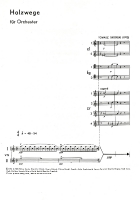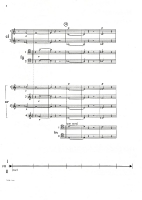Holzwege for symphony orchestra (1972)
Holzwege was written in 1972 and in the same year was premiered at the Warsaw Autumn Festival. As usual with Sikorski, the commentary included in the programme is very limited: “Holzwege – The Ways to Nowhere, was written in 1972. It is a single-movement orchestral piece inspired by Heidegger’s metaphor.” However, we do have a more detailed comment on the work by Sikorski recorded probably in 1985 by Małgorzata Gąsiorowska during her interview with the composer. Sikorski said at the time:
I was fascinated with the very word Holzwege, because I was told about it by a friend who had read that essay by Heidegger – my German was not sufficient for that. “Holzwege” are traces of trees transported in the forests, traces left by the trees either on snow or among leaves (...) and he [Heidegger] describes life as a kind of wandering, with only moments of illumination, when man finds himself in a clearing, which he calls der Lichtungstehend. My work is an ostinato, a long waiting that ends in suspension, it ends simply begging for some sort of continuation, and ends with a pause.
The composition is marked piano and its tempo is fairly monotonous and slow. The structure of the work comprises basically one movement, although we can distinguish in it three elements: the first and biggest (up to bar 55) contains brass chords with long rhythmic values against the background of an anxious ostinato of the strings in ppp (F2 – B1 tritone).The chords are usually repeated two or three times and undergo slight modifications: their duration is lengthened or shortened, the pitch of some notes is altered, the number of notes in a chord is increased or decreased, or the chord is given to different instruments. The listener has the impression that the order of the chords is accidental and that they can just as well be arranged completely differently. This happens because the sound of the chords is very similar – though at the same time sufficiently different for the listener to feel anxious and confused. This impression is enhanced by a violin ostinato, which is at once stable (continuous note F2) and completely unstable (pendular ostinato movement). It is difficult to say unequivocally whether a chord we hear has already appeared, or whether this is just an illusion. It is equally impossible to predict the sound of the next chord – it is surprising as well as familiar.
This kind of tension in the listener reaches its climax in the second section of the piece (bars 57 to 64), when a general pause is followed by a chord repeated five times – dark sounding, heavy, even oppressive. However, the persistent repetition of the chord does not bring any support or resolution. The length of each chord is different every time, which is even more confusing. The violin ostinato is constantly heard in the background.
The third section of the composition (bars 66 to 71) brings a change to the role of the strings and the wind instruments, which “take over” the tritone ostinato, while the violins are joined by the other instruments of the orchestral string quintet (violas, cellos and double basses), which are given the role hitherto performed by the wind instruments – standing, long chords. This fragment consists of two three-bar units, with the second being a semitone upward transposition of the first. As a result, what seems to be a release of tension in the form of a return to the ostinato in the second section becomes the basis for building even stronger tension never to be relieved. The whole ends with a pause, as if “begging for some sort of continuation”, to use the composer’s words.
In Holzwege the music does not “speak” about the meaning of the word “Holzwege”, but creates this meaning from scratch. The listeners are transported to a world of sounds in which this experience is happening, thus they are not so much spectators but participants. We can easily treat the symbolic word “Holzwege” and Tomasz Sikorski’s composition Holzwege as equal. It is a music that speaks and means the same in an extraordinary manner.




